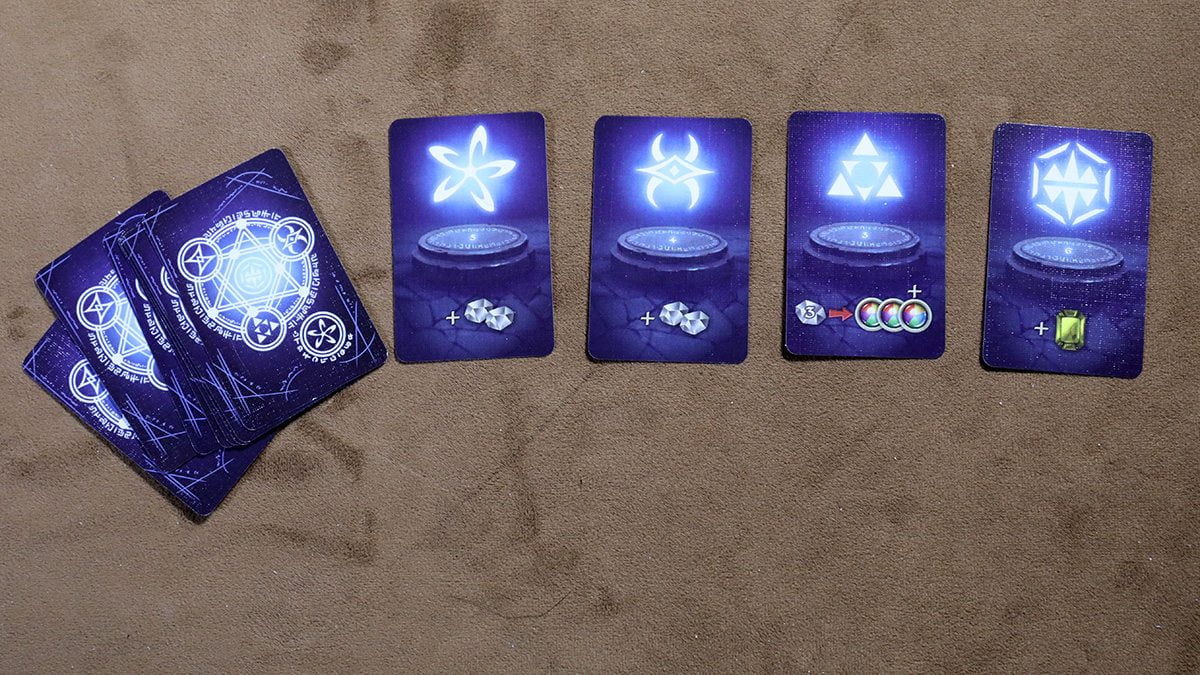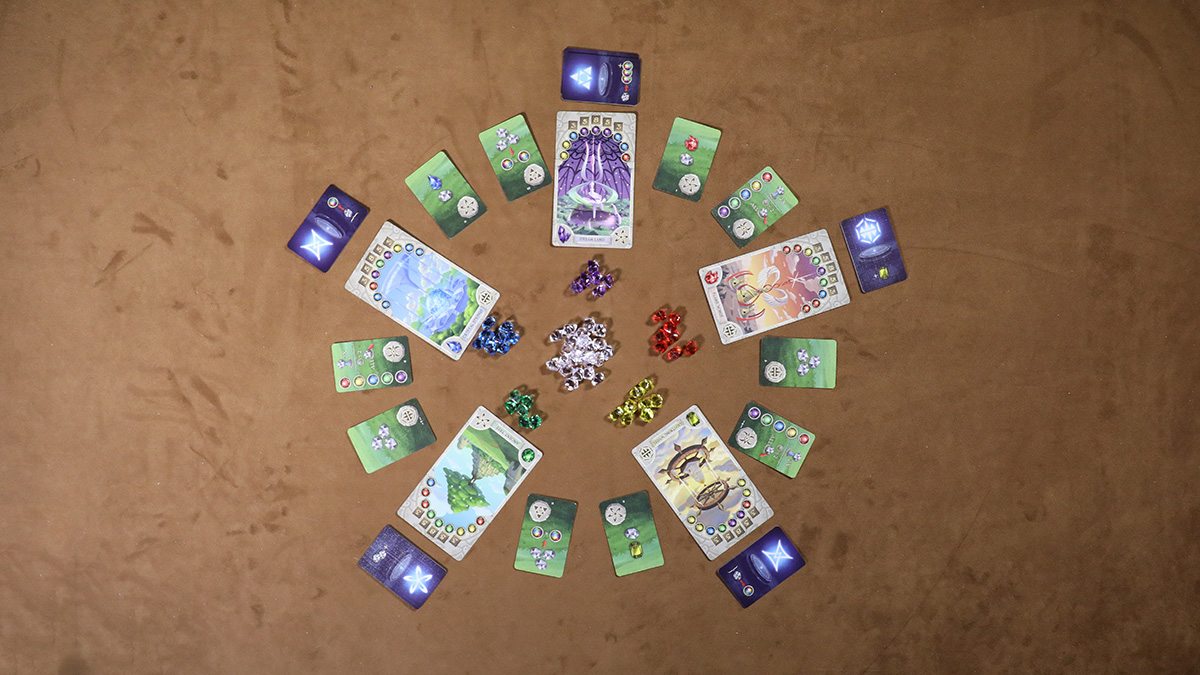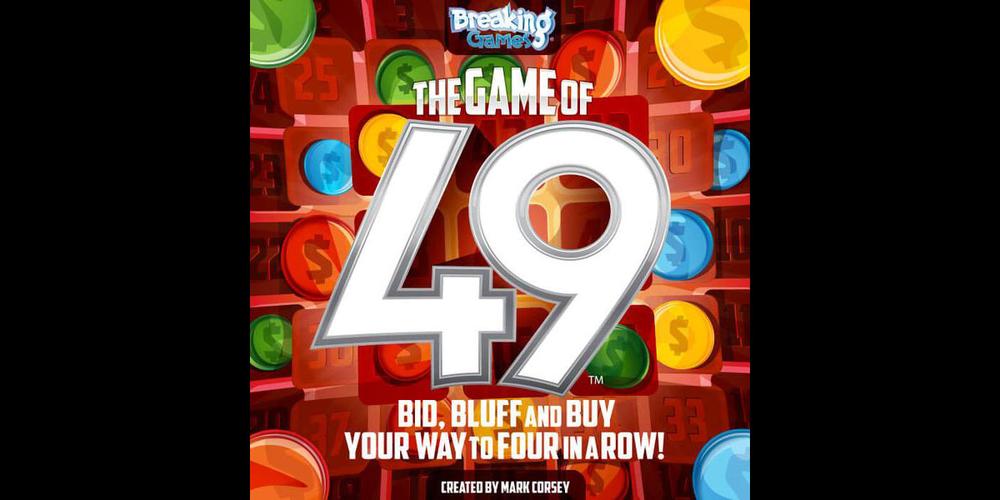Ancient ruins have been cursed by dark and deadly magic. You and your fellow cursebreakers must teleport about the world, gathering crystals, and working your own magic to break the curses. Are you brave enough?
What Is Mystery of the Temples?
Mystery of the Temples is originally a game from Emperors4, a Taiwanese game company. The game, which combines set collection and pattern recognition with area control, comes to Kickstarter today from US-based Deep Water Games. Mystery of the Temples is a 2-4 player game for players aged 10 and older. It plays in 20-40 minutes and you need to learn more about it because it is a fantastic game.
New to Kickstarter? Check out our crowdfunding primer, and visit our Kickstarter curated page for more projects we love.
Mystery of the Temples Components
The game I played was a previously published version. Prior to the Kickstarter project, the game will have some updates. More on that, below.
In the box, you’ll find:
- 5 Double-sided temple cards (choose side dependent on number of players)
- 4 Double-sided crystal grids
- 10 Wilderness cards
- 20 Rune cards
- 6 Objective cards
- 4 Reference cards
- 60 Crystals (24 clear, 8 red, 8 yellow, 8 blue, 6 green, 6 purple)
- 4 Cursebreaker meeples (1 each in 4 colors)
- 24 Broken curse markers (6 cubes each in 4 colors)
- 1 Scoring board
The temple cards are tarot card sized and each of them have a beautiful and peaceful portrait of a temple. Each also has a different crystal and a different rune on it. At the top of the card, arranged in an arch, are a series of colored circles with a number held in a square above some of them. These are the curses. The temple cards have two sides, one for four players, the other for two or three players. The crystal grids show 12 spots on the grid, interconnected by a diagonal grid. At the base of the card is an ability that is unique to that card.
Mystery of the Temples is GeekDad Approved!
The remaining cards are all mini-card sized. The rune cards have a mystical back and, on the business side, feature a rune and an ability at the bottom of the card. The wilderness cards are double-sided but the same on both sides. Two cards are noted for being pulled during a two- or three-player game. Each of the wilderness cards have a rune on them and an ability on the top. The abilities on the rune and wilderness cards allow for players to earn extra crystals or give a player the ability to execute an action for a cheaper cost.
The objective cards represent each of the five temples and one additional card that shows the runes. These cards display the areas that will provide end of game bonuses and are visible throughout the game. The artwork is very nice and has a definite mystical and magic feel to it.
The meeples and cubes are basic and the gems are small but nice, multi-faceted, and in neutral colors. The scoring board will be a standalone board, unlike the version I played with. The box will increase in size for this project, along with some translation updates and the removal of Chinese characters from some of the components. Finally, cards will be updated to help color-blind players and cardboard crystal tokens will be added (in addition to the colored, plastic gems) so that color identification need not be mandatory.
How to Play Mystery of the Temples
Setup
The setup for this game looks rather elegant. All the cards are placed in a circle, with temple cards placed at the points of a pentagram and the wilderness cards placed from 1-10, two between each temple card. (If playing two or three players, remove wilderness cards 4 and 7 and make sure the temple cards are turned to the two and three player sides.)
Next, place the colored gems next to their corresponding temples (noted by the gem in the lower left of the cards) and put the clear crystals in the center of the table. Rune cards should be shuffled and dealt in piles of four, atop each of the temples. The rune objective card should be placed where all players can see it before shuffling the remaining five objectives and dealing three next to the rune card (two in a two or three player game).
Each player gets a curse breaker character and six wooden cubes in a corresponding color. One goes to the scoring board and the rest sit in the player’s supply. Lastly, each player gets a crystal grid. Each grid has a different player power. In a beginning game, the cards are recommended. In advanced games, players should draft their grids.
That’s it, you’re ready to play.
Gameplay
Gameplay is actually very simple. On your turn, you do two things: First, move your curse breaker. Then, either gather crystals or break a curse. Easy, right? Well, there’s a lot of nuance in those brief instructions.
When moving, a curse breaker always moves clockwise and each turn, the player chooses whether to move on the temple track or the wilderness track. If you move on one track or the other, you only consider those cards and ignore the other. A player may move 1-3 spaces, skipping over and not counting any card where another code breaker is located. A card may never have more than one code breaker on it and additional movement may be purchased by trading in clear crystals. This sort of movement, skipping cards where other players are and moving between tracks from turn to turn, rewards creative thinking.
After moving a player either collects crystals or breaks curses. Curses can only be broken on temple cards, so if you’re on a wilderness card, guess what you’re doing? There are ten wilderness cards, but really only three types of actions on them. On cards 1, 3, 5, 7, and 9, there are images of crystals. You take those crystals and add them to your crystal grid (more on that in a moment).

Wilderness cards 6 and 10 allow a player to trade three clear crystals for two colored crystals. New crystals must be different from each other. Finally on cards 2, 4, and 8, a player may trade in 1 or 2 crystals for one of the available colored crystals on the card. Each color is listed once and placing a clear crystal allows the player to take that color. The clear crystals stay on the card until there are two or fewer empty slots. Additionally, there are some cards you might gain that allow the clear crystals to be wiped from the card.
In addition to wilderness cards, colored crystals may also be acquired at temple cards. Unlike the wilderness cards, you are only given a single crystal, but it’s a guaranteed pickup. When a player receives crystals, they must immediately be placed on that player’s crystal grid. Once placed they may not be moved until a curse is broken or if a player spends clear crystals to move or replace the gems already placed.

Players make break a curse by visiting a temple where their path of gems matches a curse. As the gems are added to the crystal grid, players attempt to create paths of colored gems that match the order of the curses on the temple cards. For example, on the Flame Wings temple, a player may create a path of gems in the colors red-red-yellow-green or red-red-blue-green to break the curses that earn five points. After breaking a curse, the colored gems are removed from the player’s crystal grid and returned to the supply. Additionally, the player places one of their colored broken curse markers on the curse they have broken. Each curse may only be broken once, meaning that, in a four player game, there are five curses per temple.
When a player breaks a curse, they are also awarded the top card in the rune deck above each temple. This card is placed in front of the player and gives an extra advantage for the duration of the game. When that player’s curse breaker stops on any card—wilderness or temple—that has the same rune on it as the rune card in front of the player, they get the benefit shown on the rune card. Most runes give the player extra crystals when they land on a rune, but a couple give the player a discounted cost when enjoying an exchange.
There are a handful of other rules. When using an effect, any crystal can be used when paying the cost of a clear crystal. Your grid may never have more than 12 crystals. If you ever earn more and your grid is full, you must discard them. If a player earns a crystal and there are no more left in supply, the player gets to take one from the player who has the most of that color.

If a player has placed their crystals poorly, they may spend a single clear crystal on their turn to switch the position of any two crystals on their grid. Finally, a player can turn in four clear crystals in exchange for a single gem of any color.
Play continues until a player places their fifth curse marker. Play continues until the round ends, giving each player an equal number of turns. Scoring then begins. The rulebook suggests scoring as curses are broken, but we found it easier to score everything at the end of the game. Each broken curse should be scored (at some point) and then objectives are tallied.
Players receive points on a graduating scale for having a diverse number of runes. Temple objectives consider who has scored the most points for the identified temples and give four points for first, two for second. Ties are split among those tied. Most points wins.
Why You Should Play Mystery of the Temples
I want to state, upfront, that I love Mystery of the Temples; it’s easily the best game I’ve played so far this year. Like many really fun games, Mystery of the Temples is simple to learn, but has a deeper complexity in how it’s actually played, making it tough to master. It’s an excellent family game in that its rules are easy to learn, while remaining challenging enough to keep everyone’s attention for its nearly perfect length of an average game.
Think about that ruleset—move, get crystals or break curse—what could be easier than that? But the challenge comes in what’s not in those rules. Each player has a unique power on their grid cards. Grid cards have an A and a B side; all of the A side powers are balanced together, as are the B powers, which have stronger effects. By allowing a weaker player to play a B side power, you can balance the game with more experienced players playing side A powers. It’s very enjoyable to play through with different powers and each is strong enough to make a big difference for your character. Too many games that purport to have magical characters don’t really feel like the characters are very powerful or do anything truly magical. The powers in Mystery of the Temples really make you feel like you are a powerful, magic-wielding wizard, but not at the detriment of other players’ gameplay. The powers are truly balanced.
Another challenge for players is hiding their plans on their crystal grids. Since the crystal grid cards are visible to everyone and the crystals, once placed, cannot be moved until used, it can be clear what curse a player is trying to break unless their grid path is well-hidden. In that respect, the game requires some puzzle-solving to try to riddle out what your opponents are going for. In the same vein, you must be clever in hiding your plans. The crystal grids are the clear path for future expansions to the game—there’s a lot of potential there as long as they can be kept balanced.
I love the fact that Mystery of the Temples is a challenging game for the number and size of components. I travel a good deal and I’m always looking for games with a bit of meat on them that can easily be carried in a pocket. What’s more, it doesn’t take a lot of room to play and, on a recent trip, we were able to play on a couple of airplane tables. With the sample I played, the game met those parameters. I’ll have to see if the Kickstarted version is similar.
It’s really just a pick up and deliver game, but you’ll note that, in this introduction, the game is described as much more than that. There are a full handful of mechanics that players love and will be familiar with. One of the places that Mystery of the Temples excels is in giving players options of what to do. Being able to jump between wilderness and temple track movements is freeing and, as you begin to break curses and collect ruins, the game ramps up the choices that players have to make. Factor in the player powers and there are lots of ways to quickly accumulate the crystals needed to break a curse.
If I had to come up with a complaint, I think that the theme feels a little thin. In gameplay, the theme works well and makes sense. However, and maybe it was just the translation, but I feel like an extra bit of backstory, explaining more about the land or why the curses were placed, or why we need to break them would have gone a long way in engaging players even more. That and the meeples are just boring old meeples.
One additional caveat: it is much better at four players than it is at two. When there are more players competing for resources and pursuing the same goals, it’s just more fun. (But it’s still great at two or three.)
Still, no other game has made it to my table more often this year, with happy and satisfied outcomes from all those who have played it. If you enjoy easy-to-learn games that provide enough options to challenge you game after game, you should check out Mystery of the Temples, on Kickstarter, beginning today.

Click here to see all our tabletop game reviews.
If you’d like to stay up-to-date with all of our tabletop gaming coverage, please copy this link and add it to your RSS reader.
Disclosure: GeekDad received a copy of this game for review purposes.











